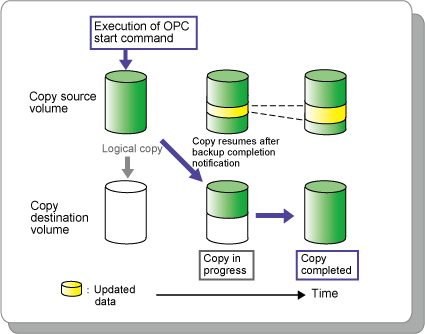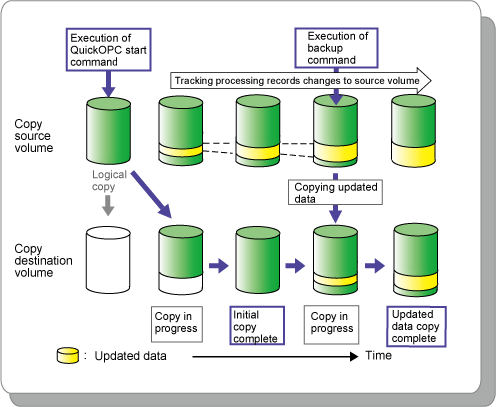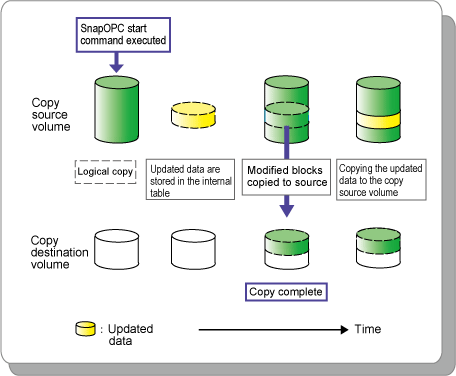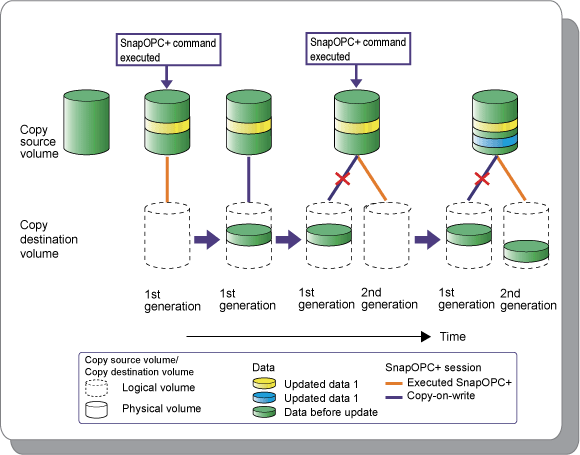AdvancedCopy Manager supports both Snapshot backup and differential copying. Point in Time recovery for high transaction database environments where roll-forward has been enabled is also available. These features are particularly effective in minimizing system downtime and server I/O load.
One Point Copy (OPC)
OPC executes a disk copy of the entire volume. The copy can be performed while the source volume remains fully accessible using the ETERNUS priority copy feature.
When the OPC command is invoked, ETERNUS creates a point in time snapshot of the source volume and then immediately returns a notification to the operator that the backup is complete, before any physical copying has even occurred. This allows for access to be returned to the transaction or source volume with little or no interruption while the copy is performed as a background process at the hardware level in the ETERNUS.
OPC is highly effective for the following applications:
Generation backups where near continuous uptime is critical such as internet business applications
OPC is the primary method for restoration from a backup volume irrespective of the backup copy method thus minimizing resultant downtime
Maintenance of data used for archival purposes
Where minimizing server I/O load is critical to overall business application performance.
The following diagram represents the process used in a One Point Copy (OPC).
Figure 2.1 One Point Copy (OPC)

Quick One Point Copy (QuickOPC)
QuickOPC is differential copy and requires that an initial copy exists.
When the QuickOPC command is invoked, it will determine if an initial copy exists, then will copy only updated blocks of data that have been tracked since the initial copy was created to the backup volume for that specific QuickOPC session.
If QuickOPC detects that an initial copy does not exist, it will create the initial copy using OPC. The differential copy method used in QuickOPC significantly reduces the time required for physical data copying in order to create a Point in Time snapshot whilst minimizing the I/O load on the storage system host server.
QuickOPC is highly effective where:
Backup to disk where uptime is critical
Creation of frequent restore points or generation backups
The following diagram represents the differential copy process used in a QuickOPC Copy after an initial copy has been created.
Figure 2.2 Quick One Point Copy (QuickOPC)

Snapshot One Point Copy (SnapOPC)
SnapOPC uses the Copy-On-Write method to create a copy of the source volume as it was before any updates are made.
In a SnapOPC copy, the destination volume does not need to be of the same size as the source volume, using a Snap Data Volume (SDV in ETERNUS) instead as the copy destination. The SDV is usually only a fraction of the size of a source volume.
When an update is required to be made to the source volume, the change is held in an internal table while the original data on the source volume is first copied to the SDV. The change is then applied to the source volume. This method of backup copy is called Copy-On-Write.
The Snap Data Volume (SDV) stores only original data that is to be modified or updated on the source volume.
The size of the SDV is relative to the rate of modification on the source volume and a utility is used to provide an accurate estimate of the size. If the source volume is relatively stable, only a relatively small SDV volume is required.
Although the physical size of the SDV maybe smaller, the logical size (that is, the size presented to the O/S) of the destination volume is in effect the same as the source volume. ACM achieves this by combining the original data copied to the SDV with the unmodified data on the source volume to form a logical view of the destination volume.
However, it should be understood that SnapOPC may be unsuitable for some purposes as the copy method can reduce access performance in the source volume, and any loss of data on the source volume would render the copied data unusable.
SnapOPC is typically used for:
Temporary source for a cascade copy to alternate media such as tape
Backup to disk for file servers and other data with a low modification rates
Figure 2.3 Snapshot One Point Copy (SnapOPC)

Snapshot One Point Copy+ (SnapOPC+)
Like SnapOPC, SnapOPC+ uses the Copy-On-Write method to create a copy of the source volume as it was before any updates are made.
SnapOPC+ can save the copy source volume data as it was before any updates are made in snap generation units (units in which replication volumes were created). Since copy is performed only to the new copy destination volume, the access load on the copy source volume and the physical size used on the copy destination volume can be smaller than with SnapOPC.
Due to the mechanism and features of SnapOPC+, it is assumed that it is used as a backup to enable recovery in case of soft faults (such as operator mistakes and software errors). If a copy source volume becomes inaccessible due to a hardware fault, then the relevant copy session becomes wrong - as a result, the data on the copy destination volume cannot be read correctly. In order to be prepared for such fatal hardware faults, Fujitsu recommends that, in conjunction with SnapOPC+, OPC/QuickOPC/EC/REC should be used to make a complete copy of data.
SnapOPC+ is typically used for:
Temporary source for an cascade copy to alternate media such as tape
Backup to disk for file servers and other data with a low modification rates
Figure 2.4 Snapshot One Point Copy+ (SnapOPC)
